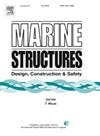Multiple-arc cylinder under flow: Vortex-induced vibration and energy harvesting
IF 5.1
2区 工程技术
Q1 ENGINEERING, CIVIL
引用次数: 0
Abstract
The shape of a cylindrical cross-section affects the vibrational performance. The vortex-induced vibration (VIV) phenomena of multiple-arc cylinders were numerically investigated to assess their impact on hydrodynamic energy harvesting and potential vibration suppression across a flow velocity range of 0.2 m/s to 1.4 m/s (1.767 × 104<Re < 1.237 × 105). The study involves five types of multiple-arc cylinders: 4-arc, 8-arc, 16-arc, 24-arc, and circular cylinders. The accuracy of the numerical method was validated through comparison with experimental data. Specifically, increasing the number of arcs generally enhances overall energy conversion efficiency. Then, the VIV response and energy conversion results of the 24-arc cylinder are similar to those of the circular cylinder with maximum efficiency. Notably, the 4-arc cylinder achieves a global maximum amplitude of 0.074 m (A∗ = 0.83) and a power output of 4.4 W with the new P + T mode, making it the most effective configuration for flow velocities between 0.7 and 0.9 m/s. For vibration suppression of multiple-arc cylinders, the appropriate arc structure effectively reduces amplitudes. The small vortices generated by the arc structures disrupt the separation of normal vortices from the boundary layer, leading to approximately a 50 % reduction in amplitude responses for 8-arc and 16-arc cylinders.
流动下的多弧圆柱体:涡流诱导振动和能量收集
圆柱截面的形状会影响振动性能。对多弧形圆柱体的涡流诱导振动(VIV)现象进行了数值研究,以评估它们在 0.2 m/s 至 1.4 m/s (1.767 × 104<Re < 1.237 × 105)流速范围内对流体动力能量收集和潜在振动抑制的影响。研究涉及五种类型的多弧气缸:4弧、8弧、16弧、24弧和圆形圆柱体。通过与实验数据的对比,验证了数值方法的准确性。具体而言,增加圆弧的数量通常会提高整体能量转换效率。然后,24 弧圆柱体的 VIV 响应和能量转换结果与效率最高的圆柱体相似。值得注意的是,在新的 P + T 模式下,4 弧形圆筒的全局最大振幅为 0.074 米(A∗ = 0.83),功率输出为 4.4 瓦,是流速介于 0.7 至 0.9 米/秒之间的最有效配置。对于多弧气缸的振动抑制,适当的弧形结构可有效降低振幅。弧形结构产生的小涡流破坏了法向涡流与边界层的分离,从而使 8 弧形和 16 弧形气缸的振幅响应降低了约 50%。
本文章由计算机程序翻译,如有差异,请以英文原文为准。
求助全文
约1分钟内获得全文
求助全文
来源期刊

Marine Structures
工程技术-工程:海洋
CiteScore
8.70
自引率
7.70%
发文量
157
审稿时长
6.4 months
期刊介绍:
This journal aims to provide a medium for presentation and discussion of the latest developments in research, design, fabrication and in-service experience relating to marine structures, i.e., all structures of steel, concrete, light alloy or composite construction having an interface with the sea, including ships, fixed and mobile offshore platforms, submarine and submersibles, pipelines, subsea systems for shallow and deep ocean operations and coastal structures such as piers.
 求助内容:
求助内容: 应助结果提醒方式:
应助结果提醒方式:


